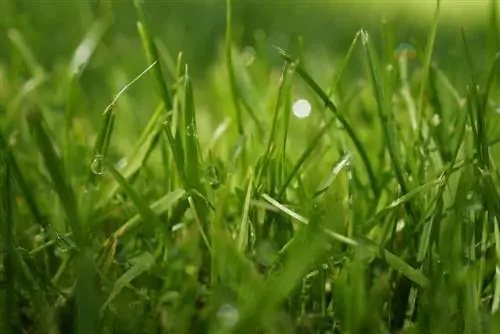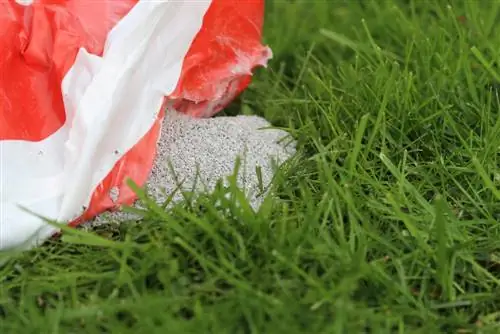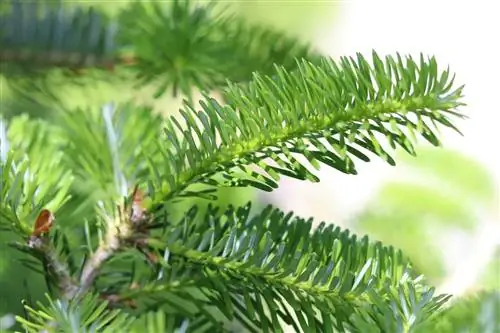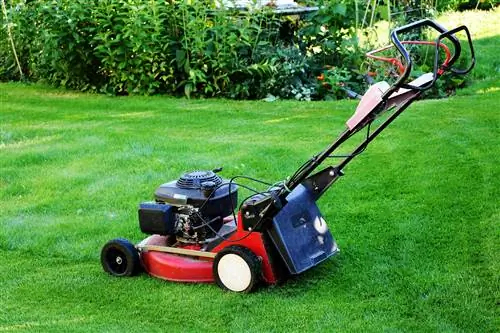- Author admin [email protected].
- Public 2023-12-17 03:39.
- Last modified 2025-01-24 12:45.
Ice and snow take a lot out of lawns. As a result, they need to be well prepared for the winter months. Fertilization is definitely part of it. However, this fertilization must take place in autumn and definitely before the first frost. It must also not stimulate growth. In addition, further care measures are necessary if there is to be a lot of beautiful greenery in the garden again in spring.
Winter break
During the winter months, the grass, like most other plants, stops growing. The time is used for regeneration - and to recharge your batteries for the new growth period in spring. At the same time, however, lawns are exposed to considerable stress during the vegetation-free period. Examples include frost on the ground or a solid blanket of snow. In order for a lawn to survive this with as little damage as possible, it should be able to start the winter break well strengthened. To do this, it is necessary to fertilize it in good time. Timely means here that the fertilizer must be applied before the first frost and the first snow. As a rule, the so-called winter fertilization is therefore more of an autumn fertilization, which should be carried out by mid-November at the latest, depending on the weather.
Note:
To prevent major damage, lawns should not be walked on during the winter months. The risk of blades of grass being seriously damaged is too great.
Winter fertilizer
Not only the timing but also the type of fertilizer is crucial for correct fertilization in autumn. Once again: the grass takes a winter break for several months. So it doesn't grow. Consequently, it makes no sense to administer nitrogen-containing or nitrogen-rich fertilizer, which is known to promote growth. Instead, at this point you rely entirely on a fertilizer that is as rich in potassium as possible. It causes the s alt content in the grass cell sap to increase. However, a higher s alt content minimizes the risk of the cells freezing and thus being damaged. Fertilizers containing a lot of potassium act like a kind of frost protection for the lawn:
Note:
Traders have special ready-made mixes that are designed to provide lawns with as much potassium as possible for the winter.
Tips for winter fertilizer application

The first thing to do is to get the right fertilizer for autumn fertilization. Then you need the right time. You should know that fertilization alone is usually not enough. The following tips also help to get the lawns in the garden well through the cold season:
- Before the start of the winter months, it is best to feed the lawn twice with a high potassium fertilizer. For example, the first fertilization can take place at the beginning of October, the second fertilization around four weeks later, i.e. at the end of October or beginning of November.
- Always apply fertilizer over large areas and well distributed. Care is particularly important here. If possible, the entire lawn area should be covered. Any defects often become noticeable in the coming year as brown spots in the green.
- Leftover fertilizer from summer must under no circumstances be used at this time. If there are any fertilizer residues left, it is best to save it for next spring. Fertilizer normally does not spoil or lose its effectiveness so quickly.
- The dosage recommendation must also be adhered to when using special winter fertilizer. The problem is not so much that there is too much potassium, but rather the fact that this fertilizer also contains a certain, albeit small, amount of nitrogen. If you give too much, there is a great risk of over-fertilization. In addition, this stimulates growth during the dormant phase in winter.
- Before the first fertilization or at the latest between the two autumn fertilization processes, the lawn should be thoroughly cared for and brought into shape. For example, it is advisable to free it from moss or remove the leaves that have fallen on it. It is simply fundamentally important that the soil is well drained. Only then can the fertilizer really have its effect.
Dealing in winter
Stems of grass should be treated like raw eggs during the winter months. They are particularly sensitive during this time and can break very easily. This also applies if they are not frozen. Children running around on the snowy lawn or building a snowman are a nightmare for the grass. The damage that can result from this is usually enormous. As a rule, you can't avoid reseeding various areas of the lawn in the spring. It always makes more sense to allow children to have fun in and with the snow on a driveway. In any case, no plants can be harmed there. The more the lawn is left alone during the vegetation break, the more magnificent it will develop again in spring.






